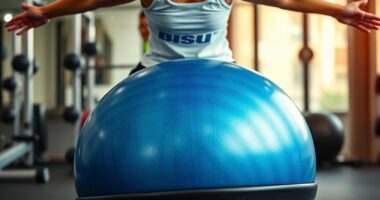Chair exercises are a safe, low-impact way to boost your strength and improve flexibility. You can do movements like arm lifts, seated twists, and resistance band exercises to target muscles in your arms, shoulders, back, and core. Keep your posture upright and move slowly for safety and effectiveness. Incorporating these simple routines regularly can help with daily activities and balance. Discover more ways to strengthen your body effectively from this seated position.
Key Takeaways
- Chair exercises safely improve muscle strength and flexibility without the need to leave the seated position.
- Incorporate seated yoga poses to enhance posture, balance, and muscle activation gradually.
- Use resistance bands or body weight for upper body exercises like arm pulls and presses.
- Maintain proper posture, controlled movements, and steady breathing for maximum effectiveness.
- Regularly practice these exercises to support daily activities, reduce fall risk, and promote overall well-being.

If you’re looking for a safe and effective way to build strength without leaving your chair, chair exercises are an excellent option. These exercises allow you to stay seated while engaging various muscle groups, making them perfect for anyone with limited mobility or those who prefer low-impact routines. One of the most accessible methods is incorporating seated yoga, which combines gentle stretching and mindfulness with strength-building poses. Seated yoga helps improve your flexibility and posture while also activating muscles that might otherwise weaken over time. For example, simple seated stretches like overhead arm reaches or twisting motions can target your core, shoulders, and back, helping to strengthen these areas gradually.
Seated yoga combines gentle stretching and mindfulness to improve flexibility, posture, and muscle strength.
Another powerful addition to your chair workout is arm resistance exercises. Using light resistance bands or even just your own body weight, you can perform movements that boost your upper body strength. For instance, while seated, you can extend your arms forward and pull back against resistance, mimicking rowing motions that strengthen your back and shoulders. Alternatively, pressing your palms together or against the sides of your chair can provide resistance for your chest and arm muscles. These arm resistance movements are easy to do and can be integrated seamlessly into your daily routine, boosting endurance and muscle tone without needing special equipment.
When practicing seated yoga or arm resistance exercises, focus on maintaining proper posture. Sit upright with your feet flat on the floor, engaging your core to support your back. Keep your movements controlled and deliberate, breathing steadily to maximize muscle engagement and relaxation. Incorporating keto diet tracking can help ensure your nutrition supports your strength-building efforts, especially if you are combining exercise with dietary changes. Remember to listen to your body—if you feel any discomfort or pain, slow down or modify the exercise. As you progress, you can increase repetitions or resistance to continue challenging your muscles and avoid plateaus.
Incorporating these chair exercises into your routine not only enhances your muscle strength but also improves your overall well-being. Strengthening your muscles helps with daily activities like standing up, walking, and maintaining balance, reducing the risk of falls. Plus, the mental benefits of engaging in regular movement, such as reduced stress and improved mood, can’t be overstated. So, whether you’re recovering from an injury, managing a chronic condition, or simply looking for a way to stay active, seated yoga and arm resistance exercises are practical, effective options. They empower you to take control of your health right from your chair, making strength training accessible and sustainable.
Frequently Asked Questions
Can Chair Exercises Improve Bone Density?
Yes, chair exercises can improve your bone health by providing weight-bearing activity that stimulates bone density. You benefit from exercise adaptations, making movements safer and more manageable. Regular chair exercises help maintain or increase bone strength, especially for those with limited mobility. Incorporating these exercises into your routine encourages consistent activity, which is key to supporting healthy bones and preventing osteoporosis.
Are Chair Exercises Suitable for Seniors With Arthritis?
Yes, chair exercises are suitable for seniors with arthritis. They can help reduce arthritis pain and improve joint flexibility without putting too much strain on your joints. You’ll find that gentle movements done while seated can increase circulation, strengthen muscles, and ease stiffness. Just make sure to start slowly, listen to your body, and consult with your healthcare provider to tailor exercises to your specific needs.
How Often Should I Do Chair Exercises Weekly?
Think of your weekly workout plan as watering a delicate plant. You should aim for 3 to 5 sessions per week, giving your muscles time to rest and grow stronger. Consistent exercise frequency helps you build stamina without overexertion. Stick to this routine, listen to your body, and you’ll nurture your strength gradually, just like tending a thriving garden that blossoms with care.
Can Chair Exercises Help With Balance and Fall Prevention?
Yes, chair exercises can help with fall prevention and balance improvement. By regularly practicing these movements, you strengthen your core and leg muscles, which are essential for stability. Improved balance reduces the risk of falls, especially as you age. Incorporate chair exercises into your routine a few times weekly to boost your confidence and safety, ensuring you stay steady and less prone to accidents.
Do Chair Exercises Replace Traditional Strength Training?
Chair exercises don’t replace traditional strength training, but they do complement it. Did you know that 65% of seniors notice improved muscle endurance from chair routines? These exercises boost chair flexibility and help maintain muscle strength, especially for those with limited mobility. While they’re effective for building muscle, combining them with resistance training offers the best overall strength benefits. So, keep using chair exercises as part of your fitness plan.
Conclusion
So, why bother with these chair exercises for strength? After all, who needs muscles when you can master the art of perfectly balanced remote control holding? But if you do want to impress your friends—or at least avoid being the weakest link in the social chain—these simple moves might just turn you into the unexpected powerhouse of the living room. Because really, nothing says “I’m strong” like lifting a cup of tea with flair.








